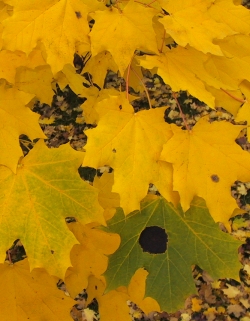Home >> Where fungi grow >> Mutualists >> Mutualisms with plants >> Endophytes
PLANT ENDOPHYTES
There are fungi, a lot of them, that are occur within the tissues of living plants. What these endophytes* are doing there is not at all clear. A number of researchers have taken plant leaves, cut them into small squares, and placed the fragments onto culture media in Petri dishes to see what would grow out. It turns out that many, in some cases all, of these small squares give rise to fungal growth. The conclusion reached by these researchers is that many leaves contain significant numbers of fungi that produce no disease symptoms in the plant, do nothing to reveal their own presence, yet remain alive and become active after the leaf drops to the ground. Very mysterious!

One fact that has been learned about endophytic fungi is that they can cause plant tissues to become extremely toxic. This is especially well-known in grasses called fescue that are used as animal fodder. When these grasses have heavy growths of endophytic fungi in their leaves they can cause serious illness or even death in animals that eat them. The toxins these fungi produce can cause neurological disorders in cattle and other animals causing them to become disoriented and unable to walk or stand. They also cause serious vasoconstriction (pinching off of blood vessels) in the legs of afflicted animals, leading to gangrene and, in severe cases, loss of a leg or hoof. If given a choice, animals will not eat endophyte-infected fodder.
Most of the toxic endophytes occurring in grasses belong to the Clavicipitaceae, a family of ascomycetes notorious because of its namesake Claviceps purpurea, the ergot fungus. The picture at right shows Epichloe typhina, a member of the Clavicipitaceae that commonly occurs as an endophyte in a number of different grasses. Although E. typhina regularly reproduces and can be observed on its grass host, many members of the family remain hidden and are never observed unless special methods are employed to detect them.
Grass endophytes are a major economic problem in warmer parts of the world. In cooler climates such as the one we enjoy in New Brunswick grass endophytes are of no cencern at all. Which calls forth another property of these fungi; they discourage insects from eating infected plants just as they do with cattle. So people living in cool climates may actually prefer grasses with endophytes. In warm climates grass seed may be guaranteed by the seller to be endophyte-free, while in cool climates they may be guaranteed to contain endophytes.
Scientists have suggested that the endophytes in grasses protect the plant from being eaten by insects and other herbivores. This is the basis for calling this system a mutualism; the plant provides the fungus with the sugars and other substances it needs for growth and it, in return, provides toxins to protect the plant. A tidy arrangement.

Grasses are not the only plants to have endophytes. In fact almost any plant can be shown to contain such fungi. Plants other than grasses contain a great variety of fungi, none of which belong to the Clavicipitaceae. While there is some evidence that these fungi protect the plant against harmful insects the case for mutualism is not as strong as it is with the grass systems. Some scientists think that these endophytes are merely fungi that feed on dead and dying plant tissues and that they enter the plant while it is still alive to get a headstart on other decay organisms. The photograph at left shows a group of Norway maple leaves still attached to the tree in October. One of the leaves is much greener than the rest and is marked by a large black spot. The spot is Rhytisma acerinum, a fungus that colonizes maple leaves in the spring as they are unfolding. It remains hidden throughout the summer and only makes its appearance when the leaves are nearly ready to fall. Its effect on the maple is unclear; in may cases it delays aging of the leaf, as it has in the photograph, but there is no evidence that this benefits the tree. Is this a case of mutualism?
_____________________________________________________________________________________________________________________________________
* The word "endophyte", derived from classical Greek, is not entirely appropriate for these associations. The prefix endo- means "inside", and the suffix -phyte means "plant". Thus the word implies a plant that lives inside something else. The word "epiphyte", used for plants like orchids that live upon other plants, is a related example where epi- means "upon". Fungi are not plants and do not deserve a terminology that suggests they are. A more correct term should be "endomycete" where the suffix -mycete means "fungus". However, the word "endophyte" has been used for the phenomenon discussed here by many authors for many years. It is embedded in the biological literature and will not be easily dislodged. Hence, on these pages we have followed the current terminology and offer only this weak protest.